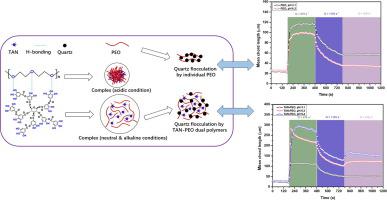Chemical Engineering Journal ( IF 15.1 ) Pub Date : 2022-06-06 , DOI: 10.1016/j.cej.2022.137403 Daowei Wang , Dong Wang , Chao Deng , Kaipeng Wang , Xiaoli Tan , Qi Liu

|
The flocculation behaviors of quartz using a dual polymer system containing tannic acid (TAN) and poly(ethylene oxide) (PEO) were investigated in this study, with dynamic floc size monitoring by the in-situ focused beam reflectance measurement technique. Variables of concern and their influence on the flocculation process were investigated from both physicochemical and hydrodynamic aspects, including solution pH, TAN/PEO ratio, and shear intensity. Floc structure was characterized using confocal scanning microscopy in suspension as well as freeze-drying-SEM imaging method. It was found that prior addition of TAN significantly increased the flocculation efficiency of quartz by PEO at neutral and alkaline pH, but not in acidic solutions despite that PEO induced the largest floc size at pH 3.1 when used alone. An optimal TAN/PEO ratio of 2 was observed for the best flocculation of quartz under the experimental conditions. Additionally, tannic acid could increase the strength of flocs formed by PEO, and the shear resistance of the flocs increased with increasing TAN/PEO ratio. The dual polymer system also contributed to the re-flocculation of quartz under cycled shear conditions, a phenomenon that was not observed when PEO was used alone. Zeta potential and adsorption density measurements confirmed that the pathway of the dual polymer flocculation was via the initial formation of TAN-PEO associative complexes in solution and then bridging of quartz by the associative complexes. The TAN-PEO associative complexes showed different structures and configurations at different pH, in line with a change in hydrogen bonding, which in turn affected floc structures and properties under turbulent conditions. This study helps to understand the improved flocculation, shear resistance and re-flocculation of fine particles induced by dual polymer system.
中文翻译:

含有单宁酸和聚环氧乙烷的双聚合物体系对石英的絮凝:聚合物化学和流体动力学条件的影响
本研究采用含单宁酸 (TAN) 和聚环氧乙烷 (PEO) 的双聚合物体系对石英的絮凝行为进行了研究,并通过原位聚焦光束反射率测量技术进行动态絮凝物尺寸监测。从物理化学和流体动力学方面研究了关注的变量及其对絮凝过程的影响,包括溶液 pH 值、TAN/PEO 比和剪切强度。使用悬浮液中的共聚焦扫描显微镜以及冷冻干燥-SEM 成像方法表征絮体结构。发现预先添加 TAN 显着提高了 PEO 在中性和碱性 pH 下对石英的絮凝效率,但在酸性溶液中却没有,尽管当单独使用时,PEO 在 pH 3.1 时诱导最大的絮凝物尺寸。在实验条件下,观察到最佳的 TAN/PEO 比率为 2,以实现石英的最佳絮凝。此外,单宁酸可以增加PEO形成的絮体的强度,并且随着TAN/PEO比的增加,絮体的抗剪强度增加。双聚合物体系还有助于石英在循环剪切条件下的重新絮凝,这种现象在单独使用 PEO 时未观察到。Zeta 电位和吸附密度测量证实双聚合物絮凝的途径是通过在溶液中初始形成 TAN-PEO 缔合配合物,然后通过缔合配合物桥接石英。TAN-PEO 缔合配合物在不同 pH 值下表现出不同的结构和构型,与氢键的变化一致,这反过来又会影响湍流条件下的絮体结构和性质。本研究有助于了解双聚合物体系对细颗粒的絮凝、抗剪切和再絮凝的改善。



























 京公网安备 11010802027423号
京公网安备 11010802027423号